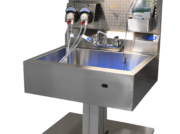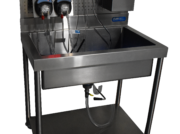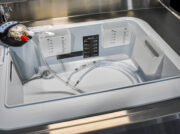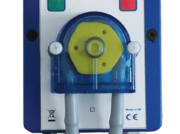
Top 5 Ways to Improve Sterile Processing Productivity
Every department is looking to improve sterile processing productivity . Reasons for this are varied, but we can all agree on its importance. Sterile processing departments must operate, as all areas of the hospital must, with efficiency, adherence to best practices, and with the highest-quality patient safety outcomes in mind. These all combine to form the basis for determining departmental productivity capabilities.
Many resources discuss how central sterile productivity can be measured in terms of output, surgical volume, or even surgery minutes. How fast can the central sterile processing department (SPD) turnover case carts? A critical consideration exists, however, that must be taken into account: equipment.
The right equipment is necessary for SPD technicians to achieve instructions for use (IFUs), reprocess devices in a consistent manner, and to avoid injury as they do so. It is also necessary to ultimately achieve productivity goals.
Here are 5 ways to improve sterile processing productivity with the right equipment.
1. Sterile processing sinks
Decontamination sinks are where a majority of SPD technicians spend the day working. Disassembling, soaking, flushing, and manual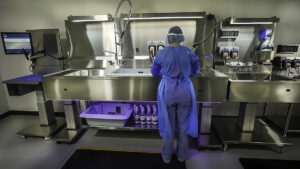 cleaning all take up quite a bit of time. Now, imagine if you had to walk all over the department just to get tools and accessories. Or if the sinks were at awkward heights and did not match the user’s physical needs. Imagine having to stop and reposition repeatedly to accomplish tasks. That would all contribute to a rapidly diminishing productivity outcome. One that can be further reduced when technicians are in pain from working in unaccommodating conditions.
cleaning all take up quite a bit of time. Now, imagine if you had to walk all over the department just to get tools and accessories. Or if the sinks were at awkward heights and did not match the user’s physical needs. Imagine having to stop and reposition repeatedly to accomplish tasks. That would all contribute to a rapidly diminishing productivity outcome. One that can be further reduced when technicians are in pain from working in unaccommodating conditions.
Your sink equipment should include the following to tackle such issues and overcome productivity roadblocks:
- Adjustable heights to accommodate different technicians
- Accessories easily within reach on back walls or shelves
- Ergonomic wrist rests to avoid injury
- Integrated temperature, enzymatic, and tracking monitors where appropriate
- Integrated and organized electrical capabilities for powered accessories
- Added lighting to assist with visual inspection in dimly departments (see ANSI/AAMI ST79:2017 3.3.5.6 for additional guidance on lighting requirements)
2. Space considerations for ideal SPD equipment
Full scale renovations may not be something your department can do this year. But productivity can take a hit when space becomes a constraint. The way to get around productivity drain is to utilize equipment specifically created to meet the physical needs of a location.
Look for equipment designed to do more with less space if your available square footage has limitations. One example is the PureSteel Xi Reprocessing Sink. The Xi Sink has a small footprint while also offering a surprising ability to accommodate larger surgical and robotic instruments with a basin maximized for such instrumentation.
3. Transport carts
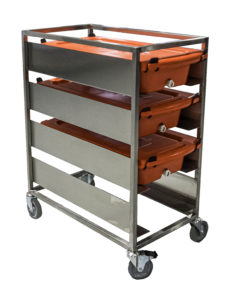 Carts are often a necessity for central sterile departments. Their use for soaking and transport may seem to be rather simple, but don’t let that fool you.
Carts are often a necessity for central sterile departments. Their use for soaking and transport may seem to be rather simple, but don’t let that fool you.
Those trusty tools can support your productivity efforts in several ways by making use of what you have available to you in terms of space and storage, increasing ease of movement, and by turning a small area into a multi-tasking space. A few examples:
- Soak instruments, rather than tie up existing sink basins necessary for rinsing and flushing
- Provide up to four levels for soaking soiled devices with just one cart
- Utilize an organizational back wall to install flushing systems and soaking timers and create all-in-one reprocessing stations
4. Soaking stations
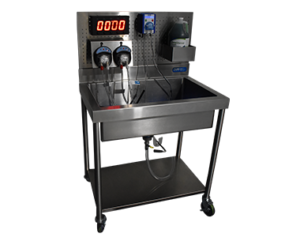 Peak reprocessing hours can create a bottleneck for productivity. And we all know the last thing we want to do is hold up the operating room or our decontamination techs. Creating and maintaining flexible workstations can solve the bottleneck and help your team accomplish more with less.
Peak reprocessing hours can create a bottleneck for productivity. And we all know the last thing we want to do is hold up the operating room or our decontamination techs. Creating and maintaining flexible workstations can solve the bottleneck and help your team accomplish more with less.
Mobile soaking stations can expand your department’s functionality while being small enough to take up minimal space. They offer many advantages:
- Create extra reprocessing sink spaces during peak reprocessing hours
- Accommodate robotic and larger orthopedic sets if your existing basins can’t fit longer instrumentation
- Rolling casters allow mobility throughout the department
- Pegboards offer installation options
- Installation without tapping existing plumbing keeps installation OSHPD-friendly
5. Flushing more than one instrument at a time
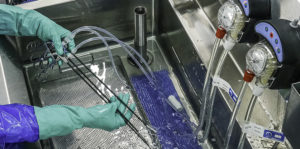 Flushing is a huge productivity block. Flushing one instrument at a time is something more and more departments are moving away from, thanks to new technologies that allow for multiple instruments to be flushed at the same time. That saves technicians time, enables them to perform additional tasks, and ensures IFU compliance.
Flushing is a huge productivity block. Flushing one instrument at a time is something more and more departments are moving away from, thanks to new technologies that allow for multiple instruments to be flushed at the same time. That saves technicians time, enables them to perform additional tasks, and ensures IFU compliance.
Equipment like the FlexiPump Independent Flushing System automatically flushes internal instrument channels and handles multiple devices at once without constantly pulling and plunging syringes for just one lumen.
Flushing productivity can also be enhanced when integrated with sink inserts, dedicated eye sinks for channeled ocular surgical devices, and automated enzymatic chemistry dispensers. These all contribute to the reduction of unnecessarily repeated tasks, the ability to perform multiple tasks at once, and creates a more ergonomically designed environment that supports your productivity goals.
It’s time to increase productivity
Measuring output and surgical volume is important for understanding SPD productivity efforts. The question is, how can you make a change? How can you increase output and support surgical volume? Training is always a good place to start. But your team also needs the right equipment and tools to diversify, perform multiple tasks to standards, and avoid injury.
Look closely at your current equipment and take stock of where it creates backlogs. Notice where technicians get stuck and why. Pay attention to how much time is lost. And then evaluate how certain changes could improve output.
Have a question about improving your department’s productivity? Contact our specialists for answers!
Pure Processing solutions are designed to accommodate any facility’s manual cleaning footprint, from tiny decontamination corners in an endoscopy lab to a full SPD “dirty side.” Systems and accessories can be selected to optimize the tasks and achieve the workflow volume of each specific department. We also offer continuing education, training and in-service, and valuable resources for SPD staff.




